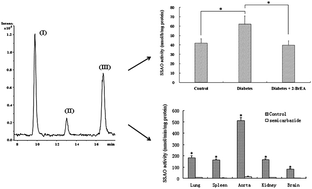LC-MS method for determining the activity of semicarbazide-sensitive amine oxidase in rodents†
Abstract
Semicarbazide-sensitive

* Corresponding authors
a
School of Life Science, Beijing Institute of Technology, Beijing, P. R. China
E-mail:
deng@bit.edu.cn
Fax: +86-10-68914907
Tel: +86-10-68915996
b Beijing Institute for Drug Control, Beijing, P. R. China
c The Research Institute of the McGill University Health Centre and the Department of Medicine, McGill University, Montreal, Quebec H3A 1A1, Canada
d Faculty of Science, Beijing University of Chemical Technology, Beijing, P. R. China
Semicarbazide-sensitive

 Please wait while we load your content...
Something went wrong. Try again?
Please wait while we load your content...
Something went wrong. Try again?
L. Wang, Y. Zhang, S. Xiao, G. Hu, B. Che, H. Qing, Y. Li, L. Zhuang and Y. Deng, Anal. Methods, 2012, 4, 1383 DOI: 10.1039/C2AY05914B
To request permission to reproduce material from this article, please go to the Copyright Clearance Center request page.
If you are an author contributing to an RSC publication, you do not need to request permission provided correct acknowledgement is given.
If you are the author of this article, you do not need to request permission to reproduce figures and diagrams provided correct acknowledgement is given. If you want to reproduce the whole article in a third-party publication (excluding your thesis/dissertation for which permission is not required) please go to the Copyright Clearance Center request page.
Read more about how to correctly acknowledge RSC content.
 Fetching data from CrossRef.
Fetching data from CrossRef.
This may take some time to load.
Loading related content
